| Western blot (WB): | 1:500-2000 |
| Immunohistochemistry (IHC): | 1:50-400 |
| Immunocytochemistry/Immunofluorescence (ICC/IF): | 1:50-400 |
| Flow Cytometry (Fixed): | 1:50-200 |
| (Boiling the paraffin sections in 10mM citrate buffer,pH6.0,or PH8.0 EDTA repair liquid for 20 mins is required for the staining of formalin/paraffin sections.) Optimal working dilutions must be determined by end user. | |

Western blot analysis of ADO using anti-ADO antibody (PB10032). The sample well of each lane was loaded with 30 ug of sample under reducing conditions.
Lane 1: human PC-3 whole cell lysates,
Lane 2: human MCF-7 whole cell lysates,
Lane 3: rat brain tissue lysates,
Lane 4: mouse heart tissue lysates,
Lane 5: mouse brain tissue lysates.
After electrophoresis, proteins were transferred to a membrane. Then the membrane was incubated with rabbit anti-ADO antigen affinity purified polyclonal antibody (PB10032) at a dilution of 1:1000 and probed with a goat anti-rabbit IgG-HRP secondary antibody (Catalog # BA1054). The signal is developed using ECL Plus Western Blotting Substrate (Catalog # AR1197). A specific band was detected for ADO at approximately 30 kDa. The expected band size for ADO is at 30 kDa.
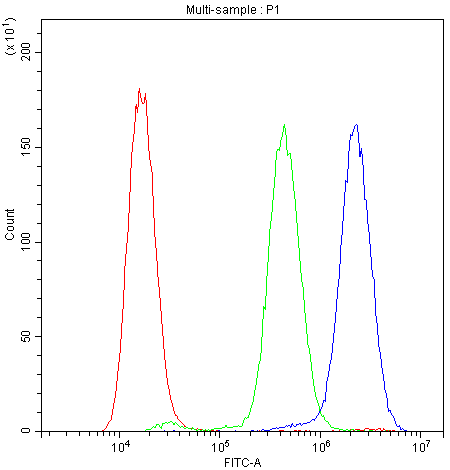
Flow Cytometry analysis of A549 cells using anti-ADO antibody (PB10032).Overlay histogram showing A549 cells stained with PB10032 (Blue line).The cells were blocked with 10% normal goat serum. And then incubated with rabbit anti-ADO Antibody (PB10032, 1:100) for 30 min at 20°C. DyLight®488 conjugated goat anti-rabbit IgG (BA1127, 1:100) was used as secondary antibody for 30 minutes at 20°C. Isotype control antibody (Green line) was rabbit IgG (1:100) used under the same conditions. Unlabelled sample (Red line) was also used as a control.
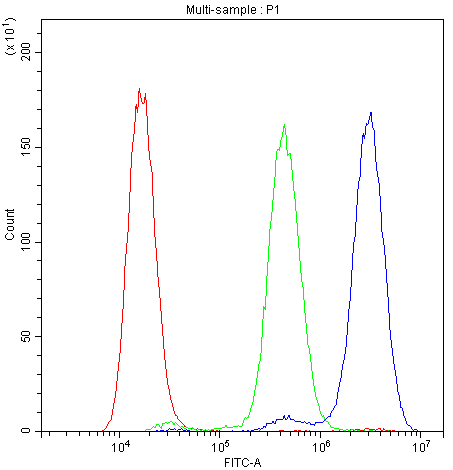
Flow Cytometry analysis of U251 cells using anti-ADO antibody (PB10032).Overlay histogram showing U251 cells stained with PB10032 (Blue line).The cells were blocked with 10% normal goat serum. And then incubated with rabbit anti-ADO Antibody (PB10032, 1:100) for 30 min at 20°C. DyLight®488 conjugated goat anti-rabbit IgG (BA1127, 1:100) was used as secondary antibody for 30 minutes at 20°C. Isotype control antibody (Green line) was rabbit IgG (1:100) used under the same conditions. Unlabelled sample (Red line) was also used as a control.
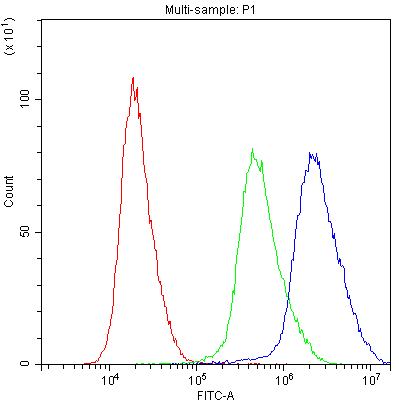
Flow Cytometry analysis of Hela cells using anti-ADO antibody (PB10032).Overlay histogram showing Hela cells stained with PB10032 (Blue line).The cells were blocked with 10% normal goat serum. And then incubated with rabbit anti-ADO Antibody (PB10032, 1:100) for 30 min at 20°C. DyLight®488 conjugated goat anti-rabbit IgG (BA1127, 1:100) was used as secondary antibody for 30 minutes at 20°C. Isotype control antibody (Green line) was rabbit IgG (1:100) used under the same conditions. Unlabelled sample (Red line) was also used as a control.

IF analysis of ADO using anti-ADO antibody (PB10032).
ADO was detected in an immunocytochemical section of A549 cells. The section was incubated with rabbit anti-ADO Antibody (PB10032) at a dilution of 1:100. DyLight®488 Conjugated Goat Anti-Rabbit IgG (Green) (Catalog # BA1127) was used as secondary antibody. The section was counterstained with DAPI (Catalog # AR1176) (Blue).
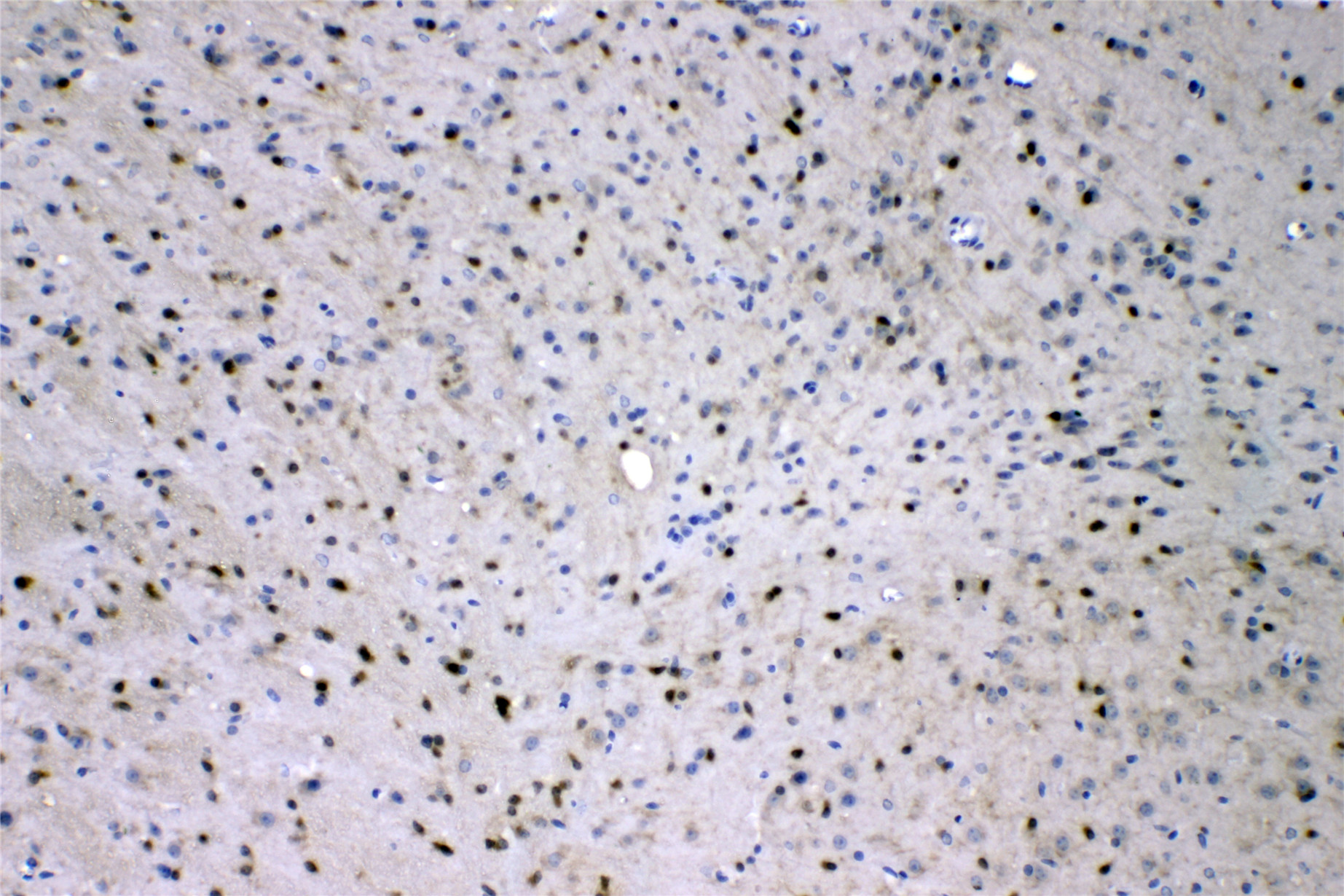
IHC analysis of ADO using anti-ADO antibody (PB10032).
ADO was detected in a paraffin-embedded section of rat brain tissue. Biotinylated goat anti-rabbit IgG was used as secondary antibody. The tissue section was incubated with rabbit anti-ADO Antibody (PB10032) at a dilution of 1:200 and developed using Strepavidin-Biotin-Complex (SABC) (Catalog # SA1022) with DAB (Catalog # AR1027) as the chromogen.
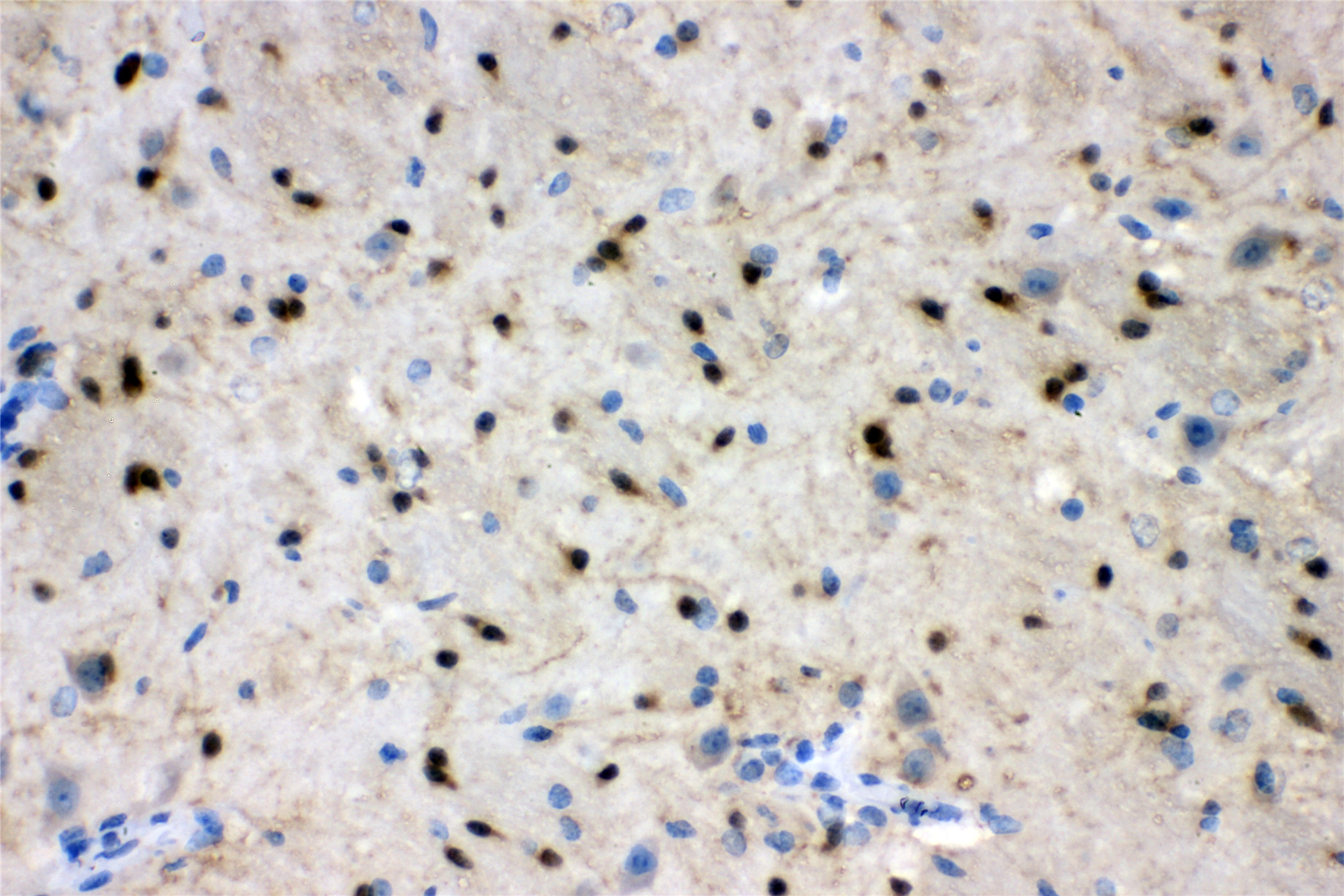
IHC analysis of ADO using anti-ADO antibody (PB10032).
ADO was detected in a paraffin-embedded section of mouse brain tissue. Biotinylated goat anti-rabbit IgG was used as secondary antibody. The tissue section was incubated with rabbit anti-ADO Antibody (PB10032) at a dilution of 1:200 and developed using Strepavidin-Biotin-Complex (SABC) (Catalog # SA1022) with DAB (Catalog # AR1027) as the chromogen.

Western blot analysis of ADO using anti-ADO antibody (PB10032). The sample well of each lane was loaded with 30 ug of sample under reducing conditions.
Lane 1: human PC-3 whole cell lysates,
Lane 2: human MCF-7 whole cell lysates,
Lane 3: rat brain tissue lysates,
Lane 4: mouse heart tissue lysates,
Lane 5: mouse brain tissue lysates.
After electrophoresis, proteins were transferred to a membrane. Then the membrane was incubated with rabbit anti-ADO antigen affinity purified polyclonal antibody (PB10032) at a dilution of 1:1000 and probed with a goat anti-rabbit IgG-HRP secondary antibody (Catalog # BA1054). The signal is developed using ECL Plus Western Blotting Substrate (Catalog # AR1197). A specific band was detected for ADO at approximately 30 kDa. The expected band size for ADO is at 30 kDa.

Flow Cytometry analysis of A549 cells using anti-ADO antibody (PB10032).Overlay histogram showing A549 cells stained with PB10032 (Blue line).The cells were blocked with 10% normal goat serum. And then incubated with rabbit anti-ADO Antibody (PB10032, 1:100) for 30 min at 20°C. DyLight®488 conjugated goat anti-rabbit IgG (BA1127, 1:100) was used as secondary antibody for 30 minutes at 20°C. Isotype control antibody (Green line) was rabbit IgG (1:100) used under the same conditions. Unlabelled sample (Red line) was also used as a control.

Flow Cytometry analysis of U251 cells using anti-ADO antibody (PB10032).Overlay histogram showing U251 cells stained with PB10032 (Blue line).The cells were blocked with 10% normal goat serum. And then incubated with rabbit anti-ADO Antibody (PB10032, 1:100) for 30 min at 20°C. DyLight®488 conjugated goat anti-rabbit IgG (BA1127, 1:100) was used as secondary antibody for 30 minutes at 20°C. Isotype control antibody (Green line) was rabbit IgG (1:100) used under the same conditions. Unlabelled sample (Red line) was also used as a control.

Flow Cytometry analysis of Hela cells using anti-ADO antibody (PB10032).Overlay histogram showing Hela cells stained with PB10032 (Blue line).The cells were blocked with 10% normal goat serum. And then incubated with rabbit anti-ADO Antibody (PB10032, 1:100) for 30 min at 20°C. DyLight®488 conjugated goat anti-rabbit IgG (BA1127, 1:100) was used as secondary antibody for 30 minutes at 20°C. Isotype control antibody (Green line) was rabbit IgG (1:100) used under the same conditions. Unlabelled sample (Red line) was also used as a control.

IF analysis of ADO using anti-ADO antibody (PB10032).
ADO was detected in an immunocytochemical section of A549 cells. The section was incubated with rabbit anti-ADO Antibody (PB10032) at a dilution of 1:100. DyLight®488 Conjugated Goat Anti-Rabbit IgG (Green) (Catalog # BA1127) was used as secondary antibody. The section was counterstained with DAPI (Catalog # AR1176) (Blue).

IHC analysis of ADO using anti-ADO antibody (PB10032).
ADO was detected in a paraffin-embedded section of rat brain tissue. Biotinylated goat anti-rabbit IgG was used as secondary antibody. The tissue section was incubated with rabbit anti-ADO Antibody (PB10032) at a dilution of 1:200 and developed using Strepavidin-Biotin-Complex (SABC) (Catalog # SA1022) with DAB (Catalog # AR1027) as the chromogen.

IHC analysis of ADO using anti-ADO antibody (PB10032).
ADO was detected in a paraffin-embedded section of mouse brain tissue. Biotinylated goat anti-rabbit IgG was used as secondary antibody. The tissue section was incubated with rabbit anti-ADO Antibody (PB10032) at a dilution of 1:200 and developed using Strepavidin-Biotin-Complex (SABC) (Catalog # SA1022) with DAB (Catalog # AR1027) as the chromogen.






